High Quality Miniature Poodles in all colours
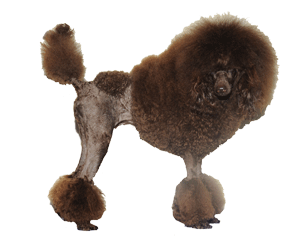
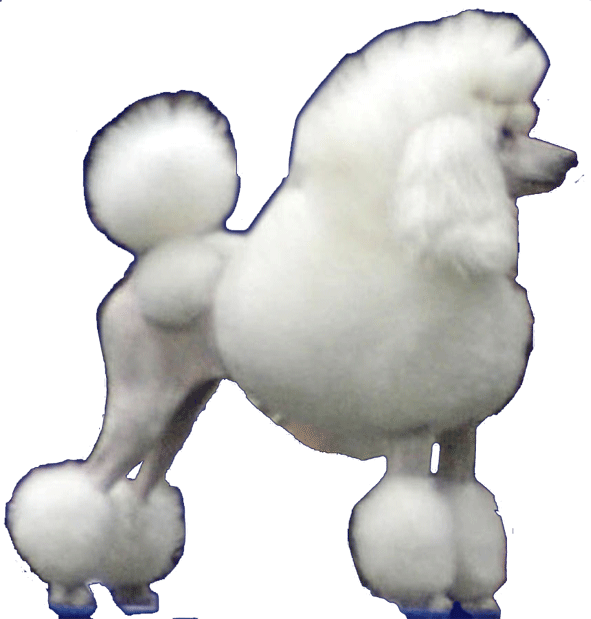
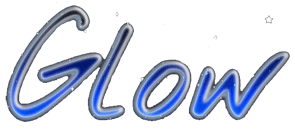
Caniches Miniatures Haute Qualité de toutes les couleurs
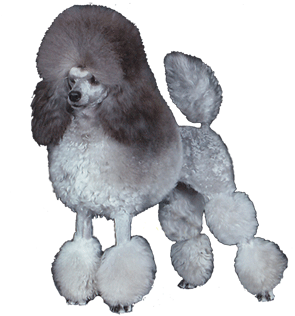
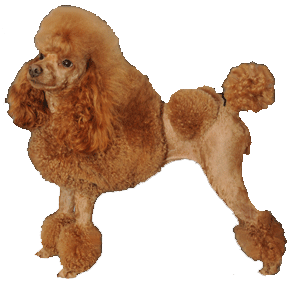
Choosing a Poodle
Being a conscientious breeder means breeding to continually improve quality of the dogs, not for financial gain. The study of genetics is very important in selecting breeding dogs. Knowing the backgrounds of the bloodlines in your dog's pedigree is essential in order to do as much as possible to prevent genetic disorders, such as such as hip dysplasia. Keep this in mind when acquiring a puppy, for only a healthy companion, full of vitality, can give you many years of shared happiness.
Pet Stores and Puppy Mills
Please: NEVER get a puppy from places such as a pet store, puppy mill or backyard breeder. A puppy mill is where dogs are bred only for financial gain, without concern for their health and the conditions in which they are raised. The genetic health and temperament do not matter, as long as the pups can be sold for cash.
If you buy from a pet store, you are only getting a puppy, secondhand, from a puppy mill. In most cases, a broker for an out-of-state puppy mill sends the pups to the pet store. These brokers acquire the pups long before they should be taken from their mothers. Normally, no shots are given and these animals are prime candidates for serious canine diseases, such as parvo and distemper. Well-intentioned people may sometimes buy from puppy mills or pet stores because they feel so sorry for the puppy. Please don't. All this purchase does is allow these terrible practices and unhealthy environments to continue, and it contributes to the profit these unscrupulous people make from mistreating dogs.
Backyard Breeders
You may pay a cheaper price for a pup from a backyard breeder, but you will not have solid information about the health and temperament. In most cases, these people do not know anything about the genetics of their breeding pair or how to produce a healthy puppy. They just decided to let their dog have a litter of pups for fun and/or money. The cheaper price is not worth the gamble you are being asked to take.
Responsible Breeders
A puppy from an ethical, reputable breeder will normally cost more. However, your are not just paying for a puppy: you are paying for years of accumulated information, education and experience. The reputable breeder has put time, knowledge and dollars into a well-planned, thoroughly researched breeding program. They are looking at the latest scientific data in an effort to produce the healthiest, happiest puppy possible, in order to offer you more years of loving companionship.
Responsible breeders will provide each buyer with a written genetic health guarantee - not a 3 to 90 day guarantee. They will want to know about you and your family in order to match you with the pup that is best suited to your lifestyle and your home environment. These breeders are educated professionals who are concerned about keeping the breed as healthy as possible for the next generations. With a deep love of the breed, in general, and their dogs, in particular, they will offer references, including giving you their vet's name and phone number. In addition, they will be there for you should any unforeseen problems arise, or to answer questions, share new knowledge and provide advice for years to come.
You get what you pay for. When the purchase price is too cheap, it may mean large vet bills and an ill puppy, or a temperament problem, down the road ahead. If you cannot afford to purchase a puppy or an older dog from a reputable breeder, please adopt from your local Humane Society, rather than from a puppy mill, pet store or backyard breeder.


People ask often about the sizes,
measured from the withers (shoulders), there are 3 sizes recognized by CKC/AKC in North America and UK :
Toy: up to 10”
Miniature: from 10” to 15”
Standard: from 15” up
In Europe and South America there are four types:
Toy: from 9 ½ to 11” (24 cm to 28 cm.)
Dwarf: from 11” to 13 ¾ “ (28 cm to 35 cm.)
Miniature: from 13 ¾ “ to 17 ¾ “ (35 cm. To 45 cm)
Standard: from 17 ¾ “ to 24 ½ “ (45 cm to 62 cm)
Les gens s'enquièrent souvent des tailles.
Il y a 3 tailles identifiées par CKC/AKC en Amérique du Nord et en Angleterre:
Jouet: jusqu'à 10”
Miniature: de 10” à 15”
Standard: de 15” et plus
En Europe et en Amérique du Sud il y a quatre types:
Jouet: de 9 ½ à 11” (24 cm à 28 cm.)
Naine: de 11” à 13 ¾ “ (28 cm à 35 cm.)
Miniature: de 13 ¾ “ à 17 ¾ “ (35 cm à 45 cm)
Standard: de 17 ¾ “ à 24 ½ “ (45 cm à 62 cm.)
Official Breed Standard for the Poodle
Breed standard approved and published by CKC in January 2005.
FOR SHOW PURPOSES, THERE ARE THREE VARIETIES OF THE POODLE BREED
STANDARD, MINIATURE AND TOY.
Origin and purpose:
The breed probably date back to the late Roman period but certainly the variety we know as the Standard Poodle was well established across the whole of Europe by the 16th century.
The Miniature and the Toy varieties developed in the next two hundred or so years. The Poodle is the world's oldest water retriever, circus performer, and truffle hunter. The ubiquitous Poodle is such a versatile dog he can be all things to all people.
General Appearance, Carriage and Condition:
That of a very active, gay, intelligent, smart, and elegant-looking dog, squarely built, well proportioned and carrying himself proudly. Properly clipped in the traditional fashion and carefully groomed, the Poodle has about him an air of distinction and dignity peculiar to himself.
Size :
The Standard Poodle is over 15 in. (38. 1 cm) at the highest point at the shoulder. Any Poodle 15 in. or less in height shall be disqualified from competition as a Standard Poodle.
The Miniature Poodle is 15 in. (38. 1 cm) or under at the highest point at the shoulder, with a minimum height in excess of 10 in. (25.4 cm). Any Poodle which is over 15 in., or 10 in. or under at the highest point at the shoulder, shall be disqualified from competition as a Miniature Poodle.
The Toy Poodle is 10 in. (25.4 cm) or under at the shoulder. Any Poodle which is more than 10 in, at the highest point at the shoulder shall be disqualified from competition as a Toy Poodle.
Coat Quality :
Curly Poodles - dense, naturally harsh texture, even length, frizzy or, curly.
Corded Poodle - all hair hanging in tight even cords of varying lengths.
Color :
Any solid color. The coat is an even solid color at the skin. In the blues, greys, silvers, browns, cafe-au-laits, apricots and creams, the coat may show varying shades of the same color. This is frequently present in the somewhat darker feathering of the ears and in the tipping of the ruff. While clear colors are definitely preferred, such natural variations in the shading of the coat are not to be considered faults.
Brown, Silver Beige and cafe-au-lait Poodles may have brown coloured noses, eye rims and lips, dark toenails and dark amber eyes.
Black, blue, grey, silver, cream, and white Poodles have black noses, eye rims and lips, and black or self-colored toenails, and very dark eyes.
In the apricots, while the foregoing color is preferred, brown noses, eye rims and lips and dark amber eyes are permitted but not desirable.
Parti-colored Poodles shall be disqualified. Parti-colored is at least two definite colours appearing in clearly defined markings at the skin.
Clip :
A Poodle under 12 months may be shown in the "puppy clip". In all regular classes, Poodles 12 months or over must be shown in the "English Saddle" or "Continental" Clip. A Poodle shown in competitive classes in any other clip shall be disqualified. However, the Brood Bitch and Stud Dog may be shown in any clip.
a) Puppy Clip: A Poodle under a year old may be shown in the Puppy Clip with the coat long, The face, throat, feet, and base of the tail are shaved. The entire shaven foot is visible. There is a pompon on the end of the tail. In order to give a neat appearance and a smooth unbroken line, shaping of the coat is permissible.
b) English Saddle Clip: In the English Saddle Clip, the face, throat. feet, forelegs and base of the tail are shaved, leaving bracelets on the forelegs and a pompon on the end of the tail. The hindquarters are covered with a short blanket of hair except for a curved shaved area on each flank and two shaved bands on each hind leg at the stifle and hock joints. The entire shaven foot and a portion of the shaven foreleg above the bracelets are visible. The rest of the body is left in full coat but may be shaped in order to ensure over-all balance.
c) Continental Clip: In the Continental Clip, the face, throat, feet and base of the tail are shaved with pompons (optional) on the hips. The legs are shaved leaving bracelets on the forelegs and rear legs. There is a pompon on the end of the tail. The entire shaven foot and a portion of the shaven foreleg above the bracelets are visible. The rest of the body is left in full coat but may be shaped to ensure over-all balance.
In all three clips the hair of the topknot may be left free, or shaped, or held in place - by not more than three elastic bands.
Head and expression:
Skull should be slightly full and moderately peaked with a slight but definite stop.
Cheekbones and muscles flat. Length from occiput to stop about the same as the length of the muzzle. Viewed from the side, the plane of the top of the skull should extend parallel to the plane of the top of the muzzle. Muzzle long, straight and fine, but strong without lippiness. Moderate chiseling under the eyes. The chin definite scissors or level bite. Nose sharp with well defined nostrils.
Eyes oval shaped, very dark. Happy, alert and full of fire and intelligence.
Ears hanging close to the head, set at or slightly below eye level. The ear leather is long, wide and thickly feathered, and when drawn forward almost reaches the nose.
Neck:
Well proportioned, strong and long enough to admit of the head being carried high and with dignity. Skin snug at the throat.
Shoulders:
Strong and smoothly muscled. The shoulder blade (scapula) is well laid back and is about the same length as the forearm (humerus).
Body:
The chest deep and moderately wide. The ribs well sprung and braced up To ensure the desirable squarely built appearance, the length of the body measured from the breast bone (sternum) to the pinbone (ischiatic tuberosity) approximates the height from the highest point at the shoulders to the ground. The back short and strong and very slightly hollowed immediately behind the withers. The loins short, broad, and muscular. Bone in proportion to the size of the dog.
Legs:
Forelegs - straight, parallel when viewed from the front. When viewed from the side, the perpendicular line falls through the fourth thoracic vertebra, the point of the scapula, the elbow at the deepest point of the brisket, and the back of the pastern. The pasterns are strong.
Hind legs - straight and parallel when viewed from the rear. When viewed from the side, muscular with width in the region of the stifles, which are well bent. Pelvis and femur are about equal in length; pad to heel short and perpendicular to the ground. When standing, the rear toes are only slightly behind the point of the rump. The angulation of the hindquarters balances that of the forequarters.
Feet:
Rather small and oval in shape. Toes well arched and close with webbing. Pads thick and firm. Nails short. The feet turn neither in nor out. Dewclaws may be removed.
Tail:
Set on high, docked and carried up. Never curled nor carried over the back.
Gait:
A straight, smooth, forward trot, verging on the single track, showing balanced reach and drive; pasterns, hocks and feet showing light springing action. Head and tail carried high. It is imperative that all three varieties be moved in the ring fully and decidedly to show correct gait.
Major faults:
Any distinct deviation from the desired characteristics described in the breed standard with particular attention to the following:
Temperament: Shyness or viciousness
Bad mouth: Undershot, overshot, wry mouth, missing teeth.
Eyes: Round protruding, large or very light
Muzzle: Down faced, dish-faced, Roman nose, snippiness
Tail: Set low, curled or carried over the back
Hindquarters: Cowhocks or sicklehocks
Feet: Flat or spread, thin pads, no webbing
Disqualifications:
Particolours, unorthodox clip, size - a Poodle over or under the height limits specified.
Scale of Points
General appearance, temperament, carriage, and condition 25
Head and expression 15
Neck and shoulders 10
Body, tail and hindquarters 10
Legs and feet 10
Coat, color and texture 10
Gait 20
TOTAL 100